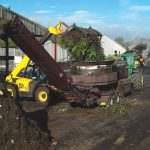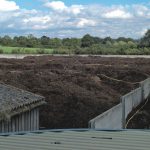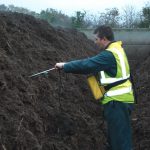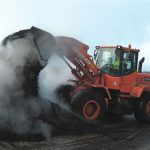Composting in the United Kingdom has been growing rapidly, with over 280 composting facilities operating at the end of 2009, and about 18 more having received planning approval, a prerequisite to facility design and construction. The three main drivers behind this industry growth are: the European Union (EU) Landfill Directive, which requires the UK to divert 65 percent of “biowaste” from landfilling by 2020; the UK’s Landfill Allowance Scheme, which imposes a landfill surcharge of $119/ton by 2013; and the EU’s Waste Framework Directive, which encourages composting and digestion of biowastes. The Landfill Scheme is one of the big drivers pushing green wastes from landfilling to composting (see “Source Separation Trends in the U.K,” August 2009).
Green waste in the UK consists mostly of green garden wastes. About 64 percent of green waste generated is collected by curbside programs, while about 28 percent comes in from drop-off sites (called “public tips”). Of the 5.2 million tons of organics composted in the UK in 2009, about 60 percent was processed in open-air windrows and 40 percent in in-vessel systems. The windrow composting operations are trying to handle so much material that most turning is done with loaders and excavators rather than windrow turners, as the green waste piles are very large (by U.S. standards).
One of the older green waste composting facilities in the UK is Shorts Composting, located on Planners Farm Road in Berkshire, west of London (about 7 miles from Windsor Castle and 11 miles from Heathrow Airport). It is in a part of England that has numerous golf courses, polo fields (called “pitches”), and old family estates. Shorts Composting is run by the Shorts Group, a family-owned agricultural services and recycling company founded in 1957. They are the only composting facility in the UK to have a Royal Warrant of Appointment by Queen Elizabeth.
Composting began at Planners Farm in 1994, following a request from an official in the local authority of nearby Bracknell Forest to have a place for green waste to be recycled. “When we started, we ground up the green waste twice a year, stacked it in a barn to rot and didn’t turn it,” says Gavin Bartlett, composting facility manager. “But over the years we have learned how to monitor the process and turn the piles.” Since then, the quantities of green waste have continued to grow to upwards of 10,000 tons/year. They are permitted to take in 25,000 tons/year, but competition for feedstocks in the UK is strong. Green waste comes in from curbside collections and public convenience centers at a gate fee of around $34/ton. To minimize on-site traffic and keep peace with nearby neighbors, the public is not allowed to drop off green waste at the facility.
Processing and Odor Control

The incoming green material is shredded with a Duratech Haybuster tub grinder equipped with a 6-inch by 8-inch screen. Larger material such as tree stumps and roots are processed by a Doppstadt 2560K slow speed shredder. Ground material is arrayed on a 1.5 acre concrete slab into 10 to 12 windrows that average 70-feet long by 16-feet wide by 10-feet high (approximately 200 tons in each). Windrows are turned with a Doosan loader equipped with a 3-cubic yard bucket. Until the recent modifications, green waste was composted in windrows for a 10-week period, then cured for 3 weeks.
 Compost screened to about three-quarter-inch particle size is sold to agriculture, mostly for cereal crops and oilseed rape; three-eighth-inch particle sized compost is sold for turf topdressing and landscaping applications. All compost produced meets the Publicly Available Specification for Composted Materials (BSI PAS 100) standards and the Compost Quality Protocol certification. “We adopted procedures to meet the PAS 100 standards as soon as they became official as we wanted to distinguish ourselves from those selling a lesser quality product,” explains Bartlett. “It has been the single most important factor increasing our compost sales.”
Compost screened to about three-quarter-inch particle size is sold to agriculture, mostly for cereal crops and oilseed rape; three-eighth-inch particle sized compost is sold for turf topdressing and landscaping applications. All compost produced meets the Publicly Available Specification for Composted Materials (BSI PAS 100) standards and the Compost Quality Protocol certification. “We adopted procedures to meet the PAS 100 standards as soon as they became official as we wanted to distinguish ourselves from those selling a lesser quality product,” explains Bartlett. “It has been the single most important factor increasing our compost sales.”
Shorts Composting is located less than 300 feet from several neighbors, and in recent years, had as many as 60 odor complaints per year. “When we had the odor issues, the Environment Agency [the national composting regulators in the UK] told us to turn our windrows more often,” says Bartlett. “So we were turning about 2,500 tons of material twice per week with the Doosan shovel, and every time we turned, we were getting complaints.”
They tried spray-on additives, but found the costs to be excessive and the results less than satisfactory. They put up windsocks so they could track the prevailing winds and installed two atomizers with citrus-based masking sprays. “The atomizers helped in that they reduced the odor complaints a little,” he says. In 2009, Shorts Composting began using the CMS2010 windrow monitoring system from Compost Manager. “That is when we really saw improvements,” Bartlett notes. “We learned that turning the windrows often wasn’t introducing oxygen as we thought, but, rather, it was disrupting the microbes and causing oxygen levels to fall.”

A hand-held probe simultaneously records oxygen, carbon dioxide, moisture and temperature data at each monitoring point in the windrow. When Shorts Composting started using the system, the algorithms in the  CMW2010 software took the monitoring data and determined that the windrows needed increased diffusion of air (i.e., more porosity in the pile) to ensure aerobic conditions in all areas. “We learned that we had to have adequate porosity to maintain aerobic conditions, and to turn less frequently,” Bartlett says. He replaced the screen in his Duratech Haybuster with the larger 6-inch by 8-inch screen to increase the particle size and enhance the chimney effect of air transfer.
CMW2010 software took the monitoring data and determined that the windrows needed increased diffusion of air (i.e., more porosity in the pile) to ensure aerobic conditions in all areas. “We learned that we had to have adequate porosity to maintain aerobic conditions, and to turn less frequently,” Bartlett says. He replaced the screen in his Duratech Haybuster with the larger 6-inch by 8-inch screen to increase the particle size and enhance the chimney effect of air transfer.
In addition, the software indicates when to irrigate the windrows and when to turn. The net effect creates a more optimized microbial composting environment, which reduced the malodors. “The only downside was we had to change the patterns of materials handling in how we moved our windrows,” Bartlett notes. “We used to move them sequentially around the perimeter of the site and now we move them to curing when the software indicates they’re done.”
Craig Coker is a Contributing Editor to BioCycle and a Principal in the firm Coker Composting & Consulting (www.cokercompost.com), near Roanoke VA. He can be reached at cscoker@verizon.net. CMS2012 (the current version of the technology) will be available in the U.S. in early 2012.











